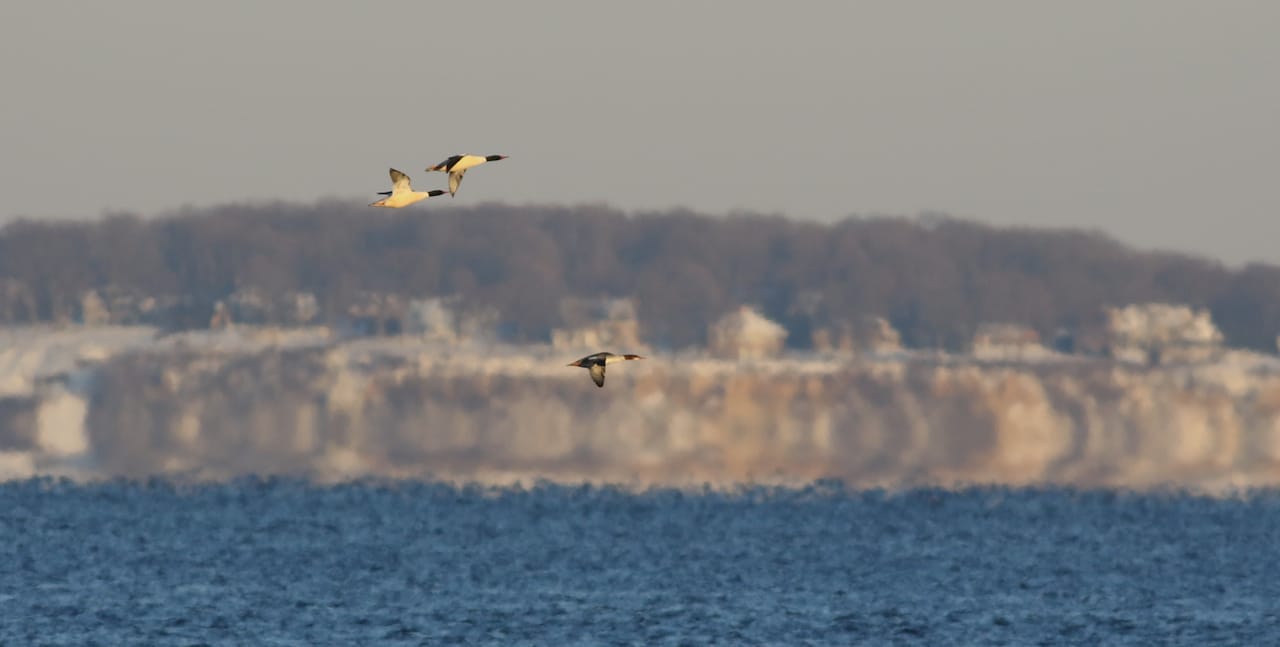|
For an updated explanation with more photos and a schematic, click HERE. "On Dec 19, 2016, Arlene Koziol sent a photo to John Kutzbach, with this message: "There was a mirage on Lake Mendota today. this was taken at Marshall Park. Thanks for teaching me about mirages John!" Here is the photo and John's answer, and if you have anything to add to round out the explanation, please click COMMENT below. "Arlene,
This picture is fantastic. It captures not only very interesting light refraction, but much more. The sharpness of the birds and the slight blurry look in the refraction zone gives it the look of an impressionist painting. You are amazing!! I wish I could explain it all. It is certainly caused by the very cold air almost in contact the warm water. The light rays bend toward the denser (colder) air as they follow the path from the object to your eye (or camera eye). In simple cases this just produces a ‘lengthened’ or ’shortened’ image of the actual object. In this case the ‘lengthened’ ‘cliff’ appears to me to be a combination of a ‘superior’ (upright) and ‘inferior’ (upside down) view of the object. The symmetry line is a horizontal line in the middle. Notice how the top and bottom of the 'lengthened cliff' are nearly exact replicates of each other - but the lower half appears inverted. If this ‘guess’ is correct, then the light rays coming from the object are actually following two paths: one is concave - this gives the upright image; one is convex - this gives the inverted image. The eye, or camera, sees both light ray paths at the same time. The two paths suggest that there is a layer of air with maximum density — and that slightly less dense air is below (at the water) and also some distance above the layer of maximum density. Since I wasn’t there some of this is guesswork. I don’t think the sideways ‘bending’ is a bending, but rather we are just seeing the upright and inverted images with the symmetry line in the middle. (Refraction should in this case - over a broad uniform temperature lake - be strictly a vertical effect and no reason for bending in the vertical ). The slight blurry look is I think an indication of some turbulent micro-eddy activity because of the extreme temperature differences between the warm water and the cold air. The cold air is being heated by the warm water below, but is always being replaced by more cold air. There may also be some water vapor present. These are all pretty much guesses because I don’t know exactly how the scene looks with ‘normal’ temperature conditions. In any case, I think you captured a very, very, very interesting mirage — I think a double mirage. Since both the superior and inferior parts are stretched and neither looks the way the object ‘normally’ looks. I agree the water does appear to float upward - this also is a refractive effect but I don’t immediately understand the light ray path that produces it. John" See more of Arlene's stunning winter photos at: photos https://www.flickr.com/photos/29411257@N00/albums/72157676255638762
0 Comments
Leave a Reply. |
AuthorGisela Kutzbach and contributors Archives
May 2022
|
|
Friends of the Lakeshore Nature Preserve
P.O. Box 5534 Madison, WI 53705 UW-Madison Lakeshore Nature Preserve website Documents |


 RSS Feed
RSS Feed
